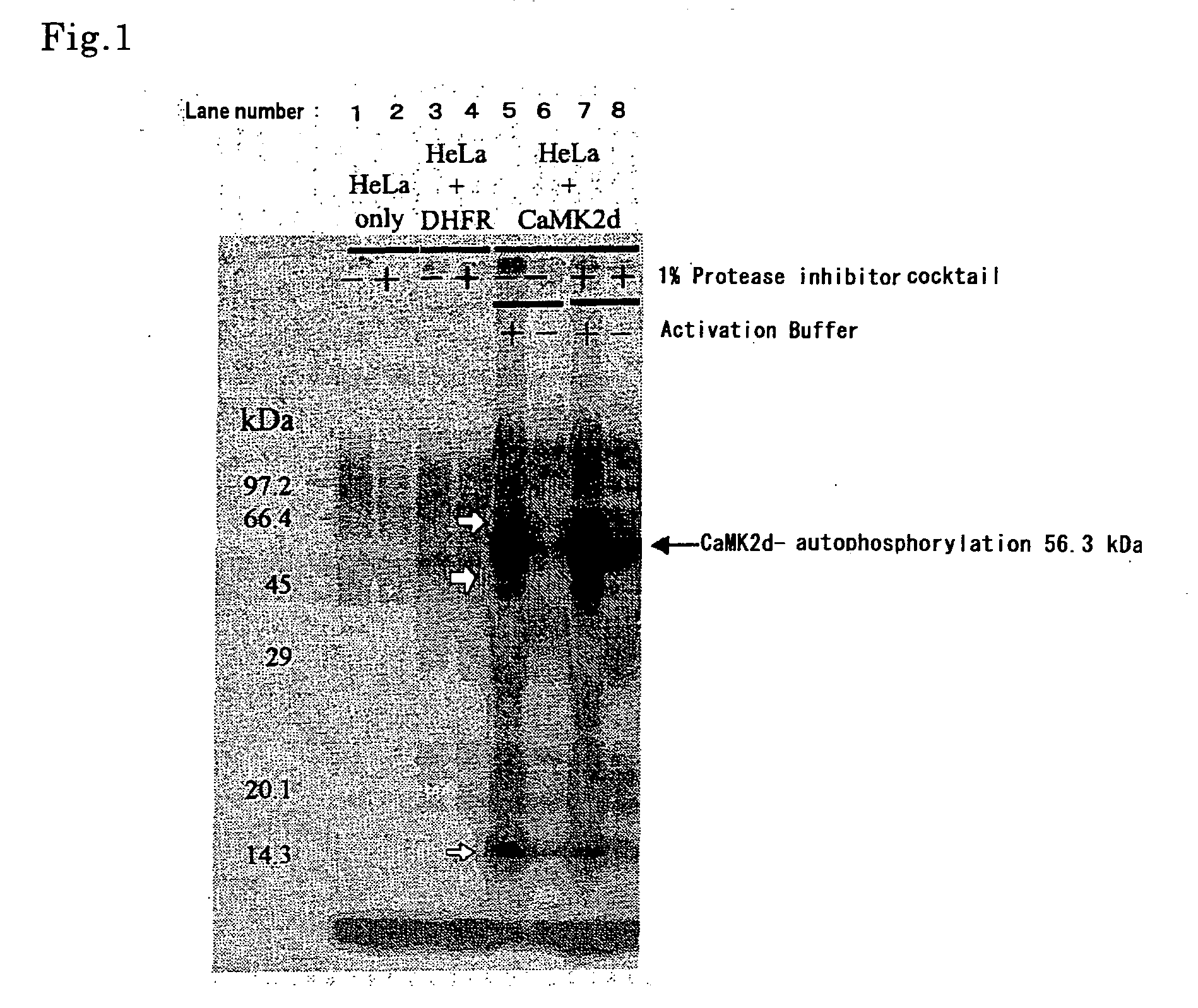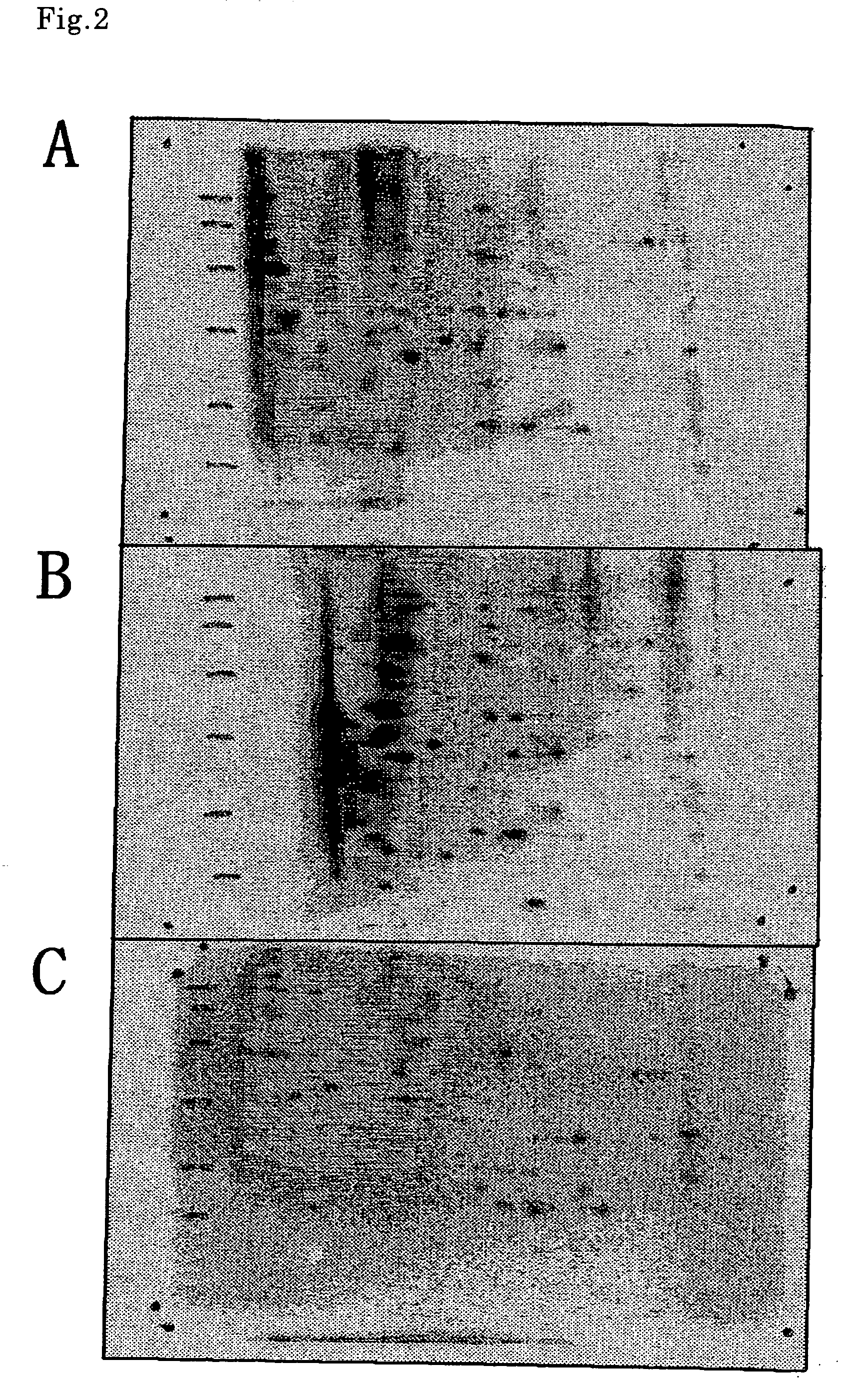Novel screening method of indicator substance
a technology of indicator substances and screening methods, applied in the field of new screening methods of indicator substances, can solve the problems of not being applied to screenings which target intermediate cannot be applied to screenings for one or more complex proteins involved in a plurality of signaling systems, so as to facilitate cell-free protein synthesis
- Summary
- Abstract
- Description
- Claims
- Application Information
AI Technical Summary
Benefits of technology
Problems solved by technology
Method used
Image
Examples
example 1
Cell-Free Protein Synthesis
[0075] (1) Preparation of Wheat Embryo Extract Solution
[0076] The seeds of Chihoku wheat produced in Hokkaido or those of Chikugoizumi produced in Ehime were fed into a mill (from Fritsch: Rotor Speed Millpulverisette Type 14) at the rate of 100 g / min, and pulverized gently at a speed of 8,000 rpm. After collecting a fraction containing a germinable wheat embryo by a sieve (sieve opening from 0.7 to 1.00 mm), selection by flotation with the mixture of carbon tetrachloride and cyclohexane (volume ratio; carbon tetrachloride: cyclohexane=2.4:1) was conducted to recover a floating fraction containing a germinable wheat embryo, then organic solvent medium was dried off at room temperature, and then mixed impurities such as seed coats were removed by blowing at room temperature to obtain a crude wheat embryo fraction.
[0077] Next, using a belt type color sorter, BLM-300K (manufacturer: Anzai Manufacturing Co., Ltd., distributor: Anzai Corporation, Ltd.), a w...
example 2
[0086] (1) Assay for HeLa Cell-Extract Solution Using CaMKIIδ as Trigger
Preparation of HeLa Cell-Extract Solution
[0087] HeLa cell was cultured to confluency in a 10 cm culture dish by a conventional method. The cells were collected with a cell scraper, placed in a 50 mL centrifuge tube containing 20 mL of PBS (-) [137 mM NaCl, 8.1 mM Na2HPO4, 2.68 mM KCl, 1.47 mM KH2PO4], centrifuged (3,000 rpm, 2 min, 4° C.) to discard the supernatant, and suspended / centrifuged in 20 mL of fresh supplied PBS (-) three times to wash. The obtained cell mass was suspended again in 20 mL of PBS (-), separated into 1.5 mL tubes by every 1 mL, centrifuged (15,000 rpm, 3 min, 4° C.) to discard the supernatant and stored at −80° C. For reaction, usually, the stored 10 tubes were used to give one unit, melt, centrifuged (15,000 rpm, 5 min, 4° C.) to discard the supernatant gently, suspended again in 10 μL of a cell extract buffer [50 mM Tris-HCl (pH7.5), 1 mM EDTA, 6 mM β-mercaptoethanol], subjected to r...
example 3
[0095] (1) Identification of HeLa Cell-Derived Protein Phosphorylated by CaMKIIδ
[0096] The phosphorylated protein derived from Hela cell was identified according to a conventional method, wherein the spot of a labeled protein was cut off from the pattern of two-dimensional electrophoresis, the labeled protein was decomposed by trypsin to give peptides, their molecular weights were determined by MALDI-TOFMS, and a human protein to which five or more of the peptides coincide in molecular weight value was searched from the database. At least 20 or more kinds of CaMKIIδ-dependently phosphorylated spots were observed, two of which were identified as shown in FIG. 3. As a result, it was confirmed that spot A was eIF4B protein and spot B was stress-induced phosphoprotein 1 (STIP1) protein.
[0097] (2) Preparation of Transcription Template for Identified Gene and Translation
[0098] 1 ml of TRIzol (Invitrogen) was added to 1×106 HeLa cells, and RNA was extracted (final concentration 100 ng / μL...
PUM
| Property | Measurement | Unit |
|---|---|---|
| pore size | aaaaa | aaaaa |
| pore size | aaaaa | aaaaa |
| temperature | aaaaa | aaaaa |
Abstract
Description
Claims
Application Information
 Login to View More
Login to View More - R&D
- Intellectual Property
- Life Sciences
- Materials
- Tech Scout
- Unparalleled Data Quality
- Higher Quality Content
- 60% Fewer Hallucinations
Browse by: Latest US Patents, China's latest patents, Technical Efficacy Thesaurus, Application Domain, Technology Topic, Popular Technical Reports.
© 2025 PatSnap. All rights reserved.Legal|Privacy policy|Modern Slavery Act Transparency Statement|Sitemap|About US| Contact US: help@patsnap.com



